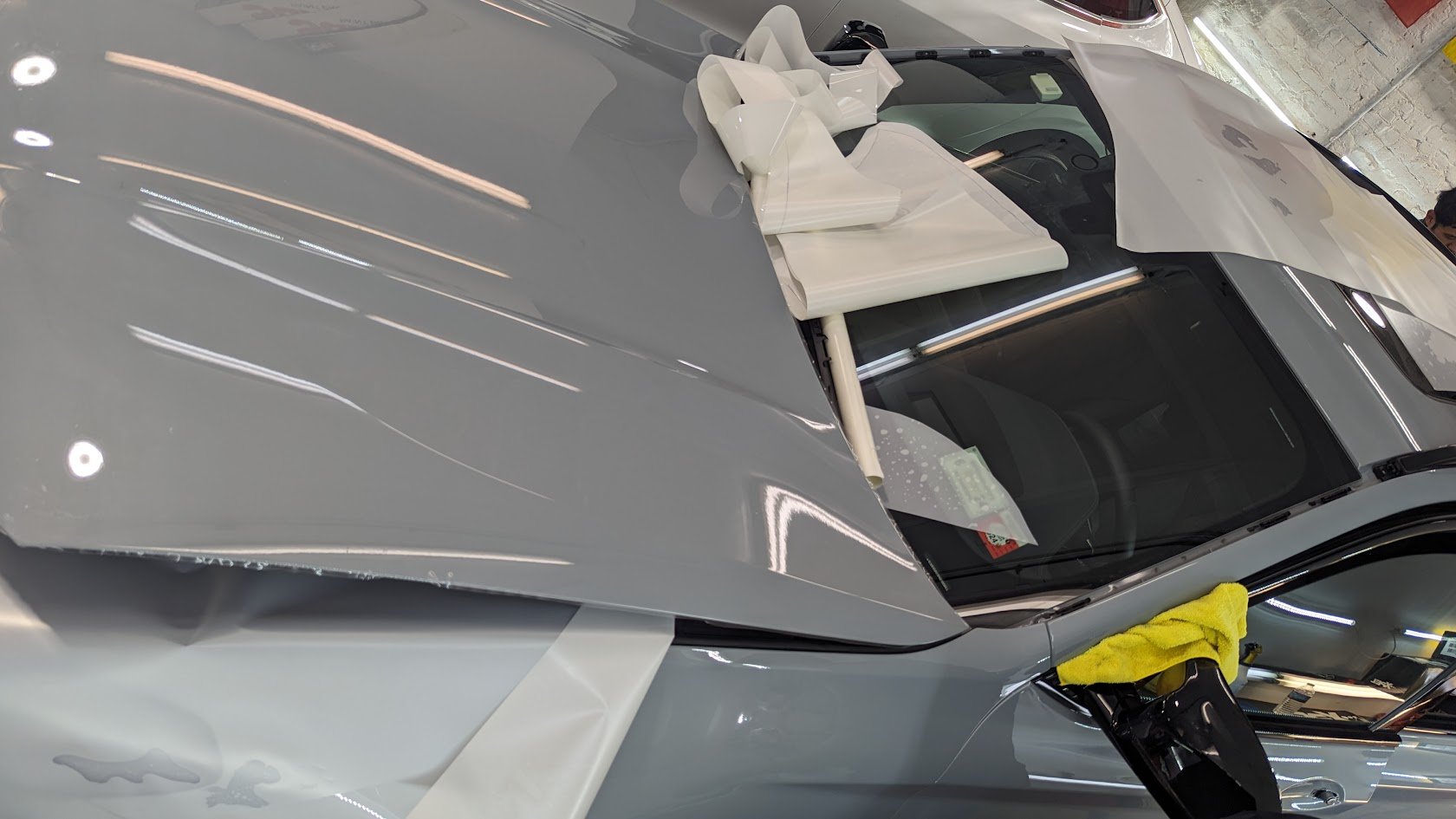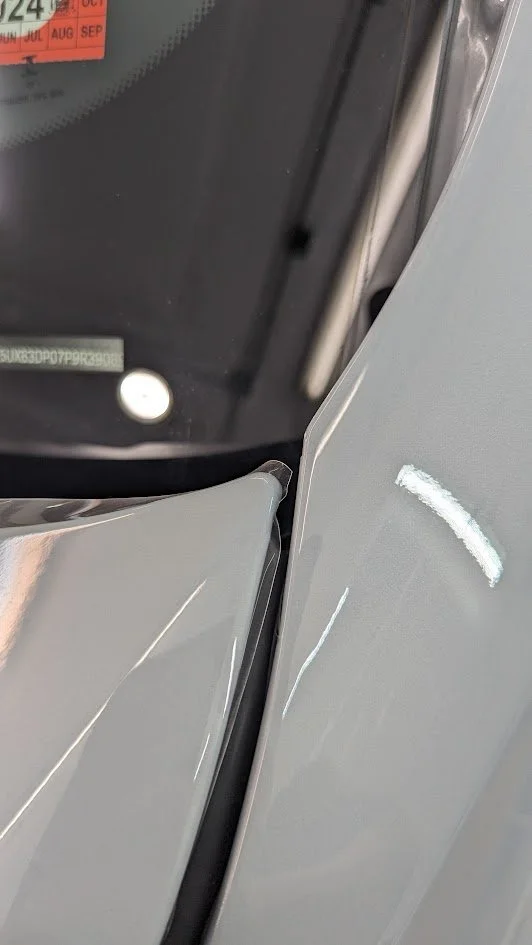
WHAT IS PPF
HOME > WHAT IS PPF
PAINT PROTECTION INFO
A General history of Paint Protection film from wikipedia
Paint Protection Film (PPF, also called clear bra, clear film or clear paint film) is a thermoplastic urethane film applied to painted surfaces of a new or used car in order to protect the paint from stone chips, bug splatters, and minor abrasions. This film is also used on airplanes, RVs, cell phones, electronics, screens, motorcycles and many other areas. Paint Protection Film is OEM approved by virtually all car manufacturers.
Paint protection film is installed on a limited basis by manufacturers on various pieces of cars at the factory (e.g. the rear arches of Porsches). This flm is most commonly applied to high impact areas of vehicles. The film is generally installed by certified trained professionals who receive supplies from outside distributors and dealers. Some tinting and detail shops also offer this service.
The primary function of clear bra is to prevent rock chips in paint, scuffs, many types of vandalism and other scenarios that result in superficial damage to car paint.
Paint protection film is mostly installed on the forward facing portions of automobiles but may also be installed on as much as a full body of a vehicle for the maximum paint protection. As with many other consumer products, paint protection films were first developed and used by the military. During the Vietnam War, helicopter rotor blades and other sensitive parts of military transports were often damaged by flying shrapnel and debris. In order to help protect these moving parts the US military asked 3M to come up with a solution that was both inconspicuous and low-weight.
The advantage of replaceable film over the replacement and repair of damaged rotor blades was immediately clear and its adoption was uncharacteristically quick for the US military. As a result, there are still people in the industry who refer to PPF as "helicopter tape" although this term is becoming less and less common as automotive applications have taken precedence.
Paint protection films use by the military has continued to the present day and 3M now makes a wide variety of aerospace and military films. With time, however, the automobile industry began to take note of the protective benefits of PPF and it was soon being employed by race car drivers despite the difficulty of working with the original films. According to Kathy Lam, marketing manager for the automotive division of 3M “The first films were thicker and less compliant, [because] their purpose was to help keep helicopter blades from eroding in the harsh, sandy environments to which they were exposed. Because the blades were flatter and less complex than automotive surfaces, they didn’t demand a highly flexible, conformable film.”
Today's automotive PPF is highly conformable and optically clear and is available in a variety of thicknesses (measured in mil in the US) and colors. New products such as 3M's Pro Series line, are multi layered and offer a self-healing top coat capable of reforming itself after being scuffed or scratched, maintaining it's clear coat for more than ten years. Contemporary applications require a slip solution or gell as a barrier keeping the film from adhearing to the painted panel. Custom and advanced applicators use steam, heat guns and torches to help apply film to complex surfaces. Pre-stretch and pre-form of films pioneered by Rommel Lyndon Villalon (Carson, CA) in 2013 are also used for complex wraps and curves. Paint protection film has many different manufacturers/distributors present in the North American market. Some of the popular film manufacturer/distributors in North America are 3M, FlexiShield, Suntek, CCL, Hexis. Training is not required to purchase XPEL, 3M, FlexiShield, Suntek, CCL,Hexis. Because installation of paint protection film has such a steep learning curve, typically requiring 3+ years of constant installation until offering a higher level of installations, most automobile owners look to expert installation facilities for the application of paint protection film.
There are different styles of installation of PPF. Many installers do not own plotters. So they are forced to bulk install film from the roll. For installers with a plotter, they can use software designed to create a pattern to the shape of the panel the film is being installed on. It is possible to modify a plotter software pattern to suit the needs of an installer and/or their customer.
Two common references to installation-styles that are the popular are "pre-cut kit" and "custom installation". Depending on the installer one is speaking with, they may feel one is superior to the other. The highest skilled installers of PPF are ones that are versed in both styles and create a solution for their customer based upon the customer's needs. Much care must be taken in selecting your PPF installers due to the sensitive nature of using knives around paint. A poorly executed PPF installation will result in damage to the body of a vehicle.
In addition to installations performed in situ at the factory or by certified shops and dealerships, there are also a select number of vendors who sell pre-cut and vehicle specific paint protection kits, as well as individuals who sell these kits on online auction sites or other markets.
Paint protection film after installation
After being properly applied, Paint Protection Film is invisible to the naked eye and does not inhibit the depth and clarity of your factory paint.
But what about over time? If you’ve done some reading around the Internet, you may have encountered individuals documenting defects that have appeared in their Clear Bra after a certain amount of time. In particular, some people who have purchased an after-market Clear Bra have noted yellowing, blistering, and peeling. For you to make an informed decision, it’s important to know what’s behind each of these de generations and what you’ll need to do to avoid them.
YELLOWING
An early complaint against Paint Protection Film was that after time it began turning yellow, which, of course, has a significant impact on the look of a vehicle’s paint, especially for white cars. This complaint was particularly prevalent when Clear Bras first started being applied to consumer automobiles. After researching the matter, film manufacturing companies found that the yellowing effect came from the adhesive that was used to bind a film to the body of a car. UV exposure was oxidizing the adhesive, which lead to discoloration. Upon this discovery, companies began researching alternative adhesives, and began using the acrylic adhesives that are found on most Clear Bras today. This newly developed adhesive is UV resistant, and will not oxidize or discolor. This effectively resolved the discoloration concern for Paint Protection Film. Today, if you put a sub-standard film on your car, it may use an inferior adhesive and lead to discoloration. But all quality professional film manufacturers, like XPEL and Suntek, use a more recently developed adhesive that does not discolor due to UV exposure.
BLISTERING
A Clear Bra is said to “blister” when small air bubbles are found underneath the film. The blistering effect has everything to do with the quality of application. Typically, an air bubble occurs because a contaminant is trapped under the film, creating separation between the body of the vehicle and the Clear Bra. Overtime this can lead to growing bubbles under the film. A proper application process includes hairsplitting attention to the vehicle’s surface before any film touches paint. This includes washing then claying. Moreover, a professional application center creates a controlled environment where the air can be filtered to remove contaminants that could potentially get trapped underneath the film. Thus, a sub-par film and unprofessional application can lead to blistering. But when a quality film is properly applied by an experienced technician, the risk is at most very minimal.
PEELING
Peeling is, of course, when the edges of a film begin to peel away from the paint. It can result from a sub-standard film or unprofessional application, but it is often the result of improper care. Specifically, if you are using a pressure wash to clean a car with Paint Protection Film, it is important to stay at least 12 inches away from the film, and particularly from any exposed edges. If a pressure washer is directed at the edge of a Clear Bra, it can begin lifting the film, which leads to peeling.
In sum, the complaints against Paint Protection Film do arise from real-world situations. However, as we have outlined, these situations have specific causes that can be averted. If you purchase a high quality film (like XPEL Ultimate or Suntek Ultra Paint Protection Film), have it installed at a reputable shop, and properly care for your protected vehicle, then the risk of defects like yellowing, blistering, or peeling are next to none. And if any of those things do occur, you will be covered by a ten year manufacturers warranty.


